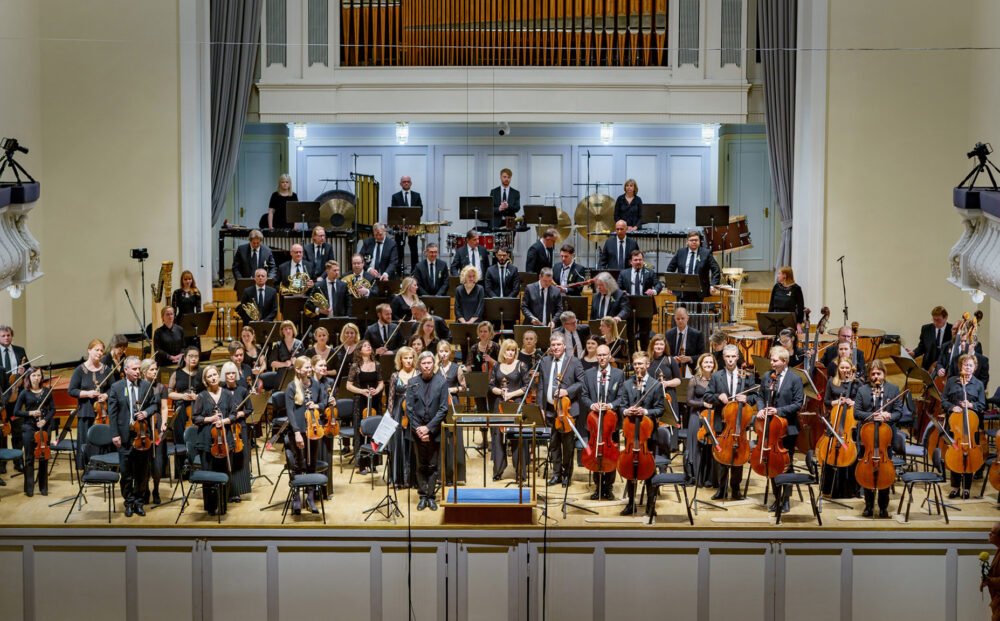
19:00
Tartu, Vanemuine Concert Hall
Venue info + map
Tickets: 28/18 €
Buy tickets
Estonian National Symphony Orchestra
soloist Valle-Rasmus Roots (cello)
conductor Clement Power
Margo Kõlar – …just one word… (1999)
Liisa Hõbepappel – And now it is still now (2024, premiere)
Age Veeroos – Harpyia, concerto for cello and orchestra (2024, premiere)
Linda Leimane – Enantiomorphic Chambers (2018)
Justina Repečkaitė – Vellum (2020)
Marius Baranauskas – Supernova (2024, premiere)
Margo Kõlar: …just one word… (1999) is an orchestral piece with a fairly dense internal structure, yet laconic in form. Indeed, just like one word. Music is everything but illustrative, but the title could be given extra breadth with Mt 8.8 (which I would not like to force upon anyone).
According to Liisa Hõbepappel, her wish as a composer is to respond to all destructive events around us, and at the same time create safe havens where to find solace. The piece And Now It Is Still Now (2024, premiere) was inspired by the verses of the French poet Bernand Noël “The Ink’s Path I”:
And now it is still now although everything slips away
Although everything flows on furrowing the skin
It is not known why or on what something passes
The throat tires from stirring the air from forming words
Something dark nocturnal tickles maybe it is exhaustion
But the world must grow old and become free
Of its borders until one body meets infinity in a dream
Not knowing that the dream is life replaced
And that everything falls silent celebrating that replacement
Still something moves in the back of your head is it
A shadow that comes and goes instantly or is it
Just a world that is finally reduced to its own thick smoke
Harpyia, a concerto for cello and orchestra (2024, premiere). Age Veeroos: ‘harpyia’ means stormy winds or a storm bird in Ancient Greek. Mythological, half-woman, half-bird harpies (evil air spirits) were the embodiments of sudden wind gusts and extreme forces of nature. They could disappear as suddenly as they came. This is also how I would describe the material I worked with in the initial phase of composing this piece and which also includes elements of calm before the storm. However, the writing process itself was like an exercise in imagining the warming climate. I studied and read about the composition of air, atmospheric and greenhouse gases, and I started wondering what I think about climate change. How great and immediate does the danger seem to me? What and how much could I do for the next generations now, while I do not have to tackle unexpected climatic phenomena? And in light of these irreversible processes, do I somehow think about the meaning of my life differently?
Enantiomorphic Chambers (2018), which took its final form on Christmas night, is Linda Leimane’s personal ‘carol’. The piece contains a structural simplicity that is atypical for her but characteristic of a chorale, with the melodic and bass lines, as well as their harmonic fill layers, in extreme slow motion. Like a peculiar Christmas archetype, this ‘chorale’ is stretched mercilessly in time, its strict rules of form becoming masked behind the scope of the moment – a constantly pulsating vibration and changes in sound colour. It is an interplay between strict canon and total freedom, between simplicity of colour and complexity, a conscious breaking from limitation into freedom.
Vellum (2020) for symphonic orchestra. Justina Repečkaitė: Vellum is a ‘membrane’ or animal skin – a parchment to write on, widely used in the mediaeval age. Vellum material represents the membrane of the drum, since the vibrational modes of percussive instruments are used to create a harmonic structure of the piece as if writing a manuscript on vellum.
Commission of the festival Gaida. Performed by Lithuanian State Symphony Orchestra conducted by Anu Tali on 30 October in the Congress Hall, Vilnius.
Supernova for symphony orchestra (2024, premiere). Marius Baranauskas: The starting point for the idea and concept of this piece was the phenomenon of a supernova – a cosmic explosion that occurs when a massive star reaches the end of its life cycle and undergoes a dramatic collapse, releasing an immense amount of energy while also generating new elements within the universe. The visual and structural inspirations drawn from this phenomenon are embodied in the musical material of the composition. Symbolically, it represents both an ending and a metaphor for new beginnings. From a structural perspective, the contrasting dynamic scale of this phenomenon is important – the phases of contraction and dramatic expansion. Within the composition, various physical parameters and visual inspirations of a supernova transform into musical form, timbres, rhythms and other sonic elements. Thus, this fascinating cosmic event resonates with us through audible and perceptible musical sounds.
One of the highlights of the Estonian Music Days is the concert of the Estonian National Symphony Orchestra (ENSO). This season, Estonian Music Days and ENSO will introduce new compositions from Estonia and other Baltic countries. The concert will be conducted by the British conductor Clement Power, who is well known as an interpreter of new music.
The “LHV New Composition Award 2024” will be presented at the concert.
18:30 – Opening of Ardo Ran Varres’ sound art installation The Sonic World of Juhan Liiv in the lobby of the Vanemuine Concert Hall.
Concert is co-organised with Estonian National Symphony Orchestra. Live broadcast by Klassikaraadio, LR3 Klasika, LRT Klasika and transferred across Europe through the EBU (European Broadcasting Union).